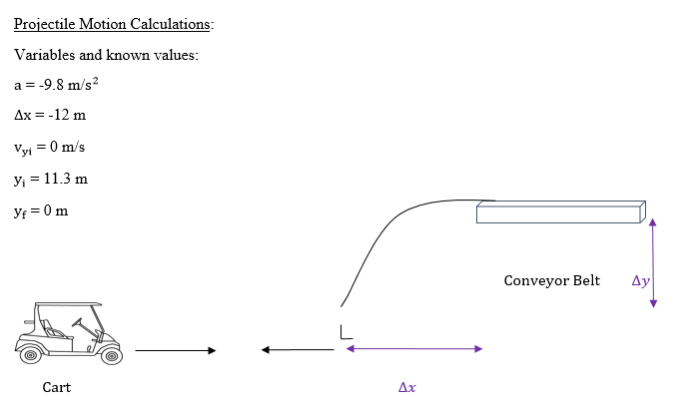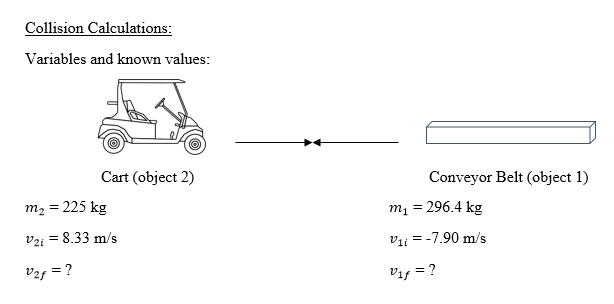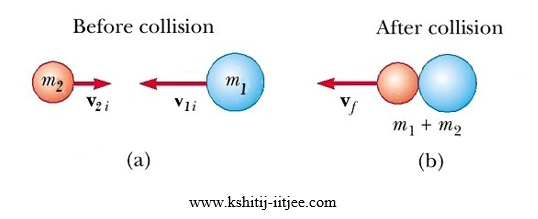Kiana R – Physics
Introduction: After the conveyor belt breaks in the factory due to inadequate equipment and moves in a circle, it falls down on the ground because of a projectile motion. The projectile gives the conveyor belt an initial velocity to collide with a cart moving in its direction. Depending on the type of collision that occurs, the results of this accident can vary greatly.
Newton’s third law of motion states that for every external force that acts on an object there is an equal but opposite force that acts back on the object which exerted the original force (Nave (“Newton’s Laws”)). This law describes the principal that the force exerted by body A on body B is equal in magnitude but opposite in direction to the reaction force exerted by body B on body A.
F1 = -F2
This fundamental law can be specifically applied to all kinds of collisions – elastic, inelastic, and perfectly inelastic. A collision occurs from the interaction of two objects and results in a force being applied to the objects. Since these bodies experience forces equal and opposite each other, they follow Newton’s third law of motion (“The Law of Action-Reaction (Revisited)”). In this factory, the conveyor belt undergoes a collision with a moving golf cart that contains a driver. The conveyor belt and the cart experience equal forces in opposite directions during the collision. While the conveyor belt exerts a negative force on the cart, the cart exerts an equal, but positive force on the conveyor belt.
Although the forces are equal and opposite, the accelerations of the objects are unequal, since Newton’s second law of motion states that acceleration is dependent upon force and mass (“The Law of Action-Reaction (Revisited)”). The conveyor belt and the cart experience unequal accelerations because of their unequal masses and due to the formula
F = ma where
- F = Force (N)
- m = mass (kg)
- a = acceleration (m/s2)
Since force is equal in both objects and mass is different, acceleration must also be different due to its inverse relationship with mass.
Masses:
- The mass of a Cricket SX-3 golf cart is 303 lbs = 137.4 kg (“Cricket SX-3 Mini Golf Cart”).
I measured the mass of a 52 year old man, assumed to be the driver. He weighed 87.6 kg.
Therefore the mass of the cart system = 137.4 kg + 87.6 kg = 225 kg
- A heavy duty DUNLOP conveyor belt with the width 1200 mm (“Conveyor Belt Design Manual”) has a mass of 24.7 kg/m.
The mass of a 12 meters conveyor belt = 24.7 kg/m X 12 m = 296.4 kg
The inverse relationship of mass and acceleration in the formula F = ma illustrates that as mass decreases, acceleration increases and vice versa. As a result, the cart experiences a greater acceleration due to its smaller mass while the conveyor belt experiences a lower acceleration due to its larger mass. We can use this relationship to figure out the relative magnitude of the objects’ initial velocities. Since acceleration  and is greater for the cart and lower for the conveyor belt when the time is the same, we can conclude that the initial velocity of the cart before collision is higher than that of the conveyor belt. This information will be useful in the calculation of the collision.
and is greater for the cart and lower for the conveyor belt when the time is the same, we can conclude that the initial velocity of the cart before collision is higher than that of the conveyor belt. This information will be useful in the calculation of the collision.
How can the factory collision be described?
- Momentum, a measure of how hard it is to stop or turn a moving object, is possessed by all moving objects that have mass and velocity (“Momentum”). Therefore both the golf cart and the conveyor belt have momentum.
- p = mv where
- p = momentum (kg*m/s)
- m = mass (kg)
- v = velocity (m/s)
- p = mv where
- Conservation of momentum states that when a collision occurs between two objects in an isolated system, the sum of the momenta of the two objects before and after the collision stays equal (“Mechanics: Momentum and Collisions”).
m1v1i + m2v2i = m1v1f + m2v2f where
- m1 = mass of object 1 (kg)
- m2 = mass of object 2 (kg)
- v1i = velocity of object 1 before the collision (m/s)
- v2i = velocity of object 2 before the collision (m/s)
- v1f = velocity of object 1 after the collision (m/s)
- v2f = velocity of object 2 after the collision (m/s)
This concept shows the idea that the momentum lost or reduced in one object during the collision is gained or increased in the other object.
But is the factory collision elastic or inelastic? The formula for conversation of momentum can be used to find each object’s velocity after the two extreme types of collisions (elastic vs perfectly inelastic). These findings will help analyze the underlying factors of each kind of collision and the different results of each scenario.
The initial velocity of the conveyor belt during the collision can be found by calculating the final horizontal velocity of the projectile motion (which equals the initial horizontal velocity of the projectile).


This velocity can be used as the initial velocity of the conveyor belt in the collision.
The cart is assumed to move with a velocity of 8.33 m/s initially because this velocity must be greater than that of the conveyor belt as illustrated earlier.

Elastic Case:
It is known that:
v1i + v1f = v2i + v2f
v2f = v1i + v1f – v2i
This equation can be substituted into the conservation of momentum equation to find v1f:
m1v1i + m2v2i = m1v1f + m2v2f
m1v1i + m2v2i = m1v1f + m2(v1i + v1f – v2i)
m1v1i + m2v2i = m1v1f + m2v1i + m2v1f – m2v2i
296.4(-7.90) + 225(8.33) = 296.4v1f + 225(-7.90) + 225v1f – 225(8.33)
-467.9 = 521.4v1f – 3652.2
521.4v1f = 3184.3
v1f = 6.11 m/s
The value of v1f is substituted into the following equation, derived previously, to calculate v2f.
v2f = v1i + v1f – v2i
v2f =-7.90 + 6.11 – 8.33
v2f = -10.1 m/s
These two values show that after the head-on collision the two objects changed direction and accelerated in the opposite direction of their initial motions.
The change in kinetic energy is calculated to see whether the elastic collision results in energy loss:
KE before
KE1 = ½ mv1i2 = ½ (296.4)(-7.90)2 = 9253.98 J
KE2 = ½ mv2i2 = ½ (225)(8.33)2 = 7806.25 J
Total = 9253.98 + 7806.25 = 17060.23 J = 1.71E4 J
KE after
KE1 = ½ mv1f2 = ½ (296.4)(6.11)2 = 5527.54 J
KE2 = ½ mv2f2 = ½ (225)(-10.1)2 = 11532.68 J
Total = 5527.54 + 11532.68 = 17060.23 J = 1.71E4 J –> no energy loss is seen.

Perfectly Inelastic Case: In this kind of collision, the final velocities are equal.
m1v1i + m2v2i = m1v1f + m2v2f
m1v1i + m2v2i = vf (m1 + m2)
296.4 (-7.90) + 225 (8.33) = vf (296.4 + 225)
-467.92 = vf (521.4)
vf = -0.897 m/s
The change in kinetic energy is calculated to see whether the perfectly inelastic collision results in energy loss:
KE before
KE1 = ½ mv1i2 = ½ (296.4)(-7.90)2 = 9253.98 J
KE2 = ½ mv2i2 = ½ (225)(8.33)2 = 7806.25 J
Total = 9253.98 + 7806.25 = 17060.23 J = 1.71E4 J
KE after
KE1 = ½ mv1f2 = ½ (296.4)(-0.897)2 = 119.36 J
KE2 = ½ mv2f2 = ½ (225)(-0.897)2 =90.61 J
Total = 119.36 + 90.61 = 209.96 J = 2.10E2 J
–> Energy loss = 17060.23 – 209.96 = 16850.26 J = 1.69E4 J energy loss

Evaluation of the two collision types:
In the first scenario, the collision between the cart and the conveyer belt is elastic. An elastic collision is a collision in which linear momentum and kinetic energy are conserved (“Elastic Collision”). In such collisions no deformations occur. As a result, if this collision was elastic, neither the conveyor belt nor the golf cart would have been deformed. As a result, no major damage would have been exerted on the driver of the cart. In such collisions, the object with the smaller mass and therefore higher initial velocity will have a higher velocity than the more massive object after the collision (Nave (“Collisions”)). This was the case in the elastic collision scenario. The magnitude of the final velocity of the lighter object (cart) was 10.1 m/s while that of the more massive conveyor belt was only 6.11 m/s. In this scenario, since the total energy was conserved before and after the collision, there was no energy loss. This would lead to the accident creating no heat or noise since there is no energy lost that can transform into heat or sound energy.
In the second scenario, the collision between the cart and the conveyor belt is perfectly inelastic. According to the definition of a perfectly inelastic collision, this case lost its maximum amount of kinetic energy (“Perfectly Inelastic Collision.”). This collision would create heat and noise as this lost energy transforms into heat and sound energy. In perfectly inelastic collisions the two objects stick together, act as one system, and move in one direction with the same velocity. Similarly, in the factory, if the collision was perfectly inelastic, the conveyor belt and the golf cart would stick together and move in the negative direction with a velocity of 0.897 m/s. The two objects would also undergo a deformation since in perfectly inelastic collisions maximum amounts deformation occur. As a result, the driver of the cart would suffer a serious damage in this collision type.
Comparing the two cases demonstrates that a perfectly inelastic collision would be more harmful as it would have negative effects on the objects and the person while leading to severe energy loss.
What type of collision is the factory collision more likely to be?
To answer this question, it is important to consider the building materials of the objects. Substances like rubber include the property of elasticity, the tendency of an object to restore to its original shape after distortion (Nave (“Collisions”)). These objects undergo deformation but with complete recovery. They initially deform when collision forces are applied to them and return to their original shape with the removal of the forces. Polymer networks, substances that exhibit high elasticity, consist of polymer chains that form giant macromolecules. They have the ability to undergo reversible deformations (“High Elasticity of Polymer Networks”). In these substances, elasticity is caused by the stretching of the chains when collision forces are applied. During the collision they store the kinetic energy as elastic energy and convert it back into kinetic energy after the collision forces are removed and the chains are returned to their initial shape. As a result, these substances undergo elastic collision since they contribute to zero energy loss and no final deformations.
On the other hand, substances such as structural metals, steel, and glass undergo inelastic collisions as they tend to bend, break, and deform during a collision. They also create a loud noise, implying the idea that they lose kinetic energy – an underlying characteristic of inelastic collisions (Integrated Teaching and Learning Program). However, since unlike polymers, these objects are unable to conserve energy, they cannot bounce off each other during a collision and stick together – a characteristic of perfectly inelastic collisions. This feature illustrate the idea that these substances are more likely to undergo perfectly inelastic collisions.
In the factory collision, the conveyor belt is Cut resistant XT Rubber Belting (“Cricket SX-3 Mini Golf Cart”) and is covered with high natural rubber. The golf cart is polymer-reinforced plastic (“Cricket SX-3 Mini Golf Cart”). Both these objects are high on elasticity and therefore more likely to undergo an elastic collision.
Conclusion: The two types of collisions explored are the two extreme cases of a collision and the factory collision can fall anywhere between these two extremes. The amount of kinetic energy loss can vary from no loss in elastic collisions to maximum loss in perfectly inelastic collisions. Similarly, the severity of deformations may vary from no deformation in elastic collisions to the maximum, permanent damage in perfectly inelastic collisions. Overall, although the factory collision can fall in between the two extremes, the materials of the objects make it very likely to be elastic – the more favorable collision due to its limited negative effects.
Bibliography:
“Conveyor Belt Design Manual.” DUNLOP Belting. N.p., n.d. Web. 22 Mar. 2016. http://www.ckit.co.za/secure/conveyor/troughed/belt_tension/dunlop-belting.htm
“Cricket SX-3 Mini Golf Cart.” Humphreys’ Outdoor Power. N.p., n.d. Web. 25 Mar. 2016. http://www.humphreysoutdoorpower.com/cicket-mini-golf-carts/cricket-sx-3-mini-golf-cart
“ELASTIC AND INELASTIC COLLISIONS IN ONE DIMENSION.” Kshitij Education. N.p., n.d. Web. 29 Mar. 2016. http://www.kshitij-iitjee.com/elastic-and-inelastic-collision
“Elastic Collision.” Real World Physics Problems. N.p., n.d. Web. 24 Mar. 2016. http://www.real-world-physics-problems.com/elastic-collision.html
“High Elasticity of Polymer Networks.” (n.d.): 2. Web. 30 Mar. 2016. https://polly.phys.msu.ru/ru/education/courses/polymer-intro/lecture3.pdf
Integrated Teaching and Learning Program, College of Engineering, University of Colorado Boulder. “Lesson: Crash! Bang!” TeachEngineering. N.p., n.d. Web. 30 Mar. 2016. https://www.teachengineering.org/view_lesson.php?url=collection/cub_/lessons/cub_mechanics/cub_mechanics_lesson03.xml
“Mechanics: Momentum and Collisions.” The Physics Classroom. N.p., n.d. Web. 23 Mar. 2016. http://www.physicsclassroom.com/calcpad/momentum
“Momentum.” The Physics Classroom. N.p., n.d. Web. 23 Mar. 2016. http://www.physicsclassroom.com/Class/momentum/u4l1a.cfm
“MOMENTUM AND COLLISIONS.” Lesson 6. N.p., n.d. Web. 29 Mar. 2016. http://titan.bloomfield.edu/facstaff/dnicolai/Physics/Physics105/Phy105-lessons/lesson6-105.htm
Nave, R. “Collisions.” HyperPhysics. N.p., n.d. Web. 23 Mar. 2016. http://hyperphysics.phy-astr.gsu.edu/hbase/colsta.html
Nave, R. “Elasticity.” HyperPhysics. N.p., n.d. Web. 30 Mar. 2016. http://hyperphysics.phy-astr.gsu.edu/hbase/permot2.html
Nave, R. “Newton’s Laws.” HyperPhysics. N.p., n.d. Web. 23 Mar. 2016. http://hyperphysics.phy-astr.gsu.edu/hbase/newt.html
“Perfectly Inelastic Collision.” About Education. N.p., 4 Dec. 2014. Web. 23 Mar. 2016. http://physics.about.com/od/physicsmtop/g/PerfectlyInelasticCollision.htm
“The Law of Action-Reaction (Revisited).” The Physics Classroom. N.p., n.d. Web. 22 Mar. 2016. http://www.physicsclassroom.com/class/momentum/Lesson-2/The-Law-of-Action-Reaction-%28Revisited%29